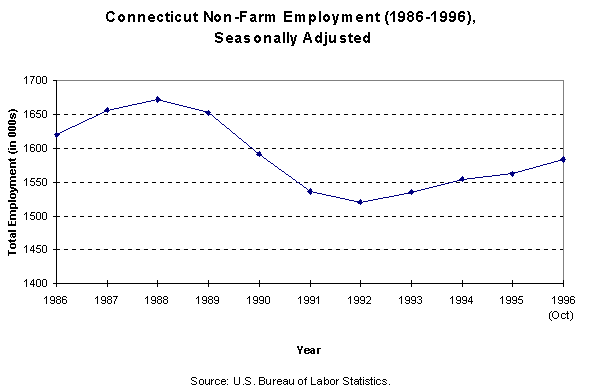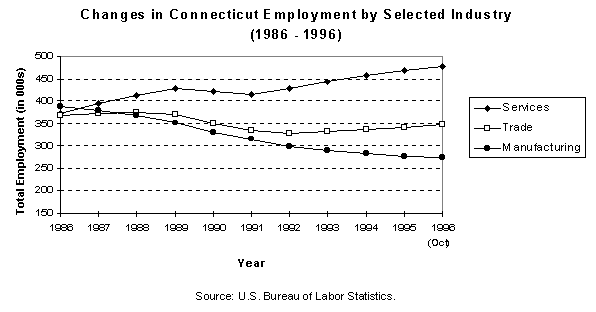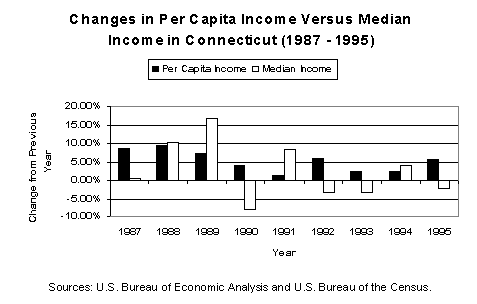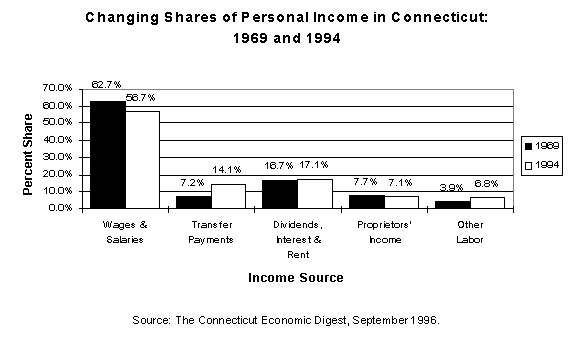![]()
Employment
Connecticut's economy has been slow to emerge from a recession that began in early 1989
and ended in late 1992. During the recovery period, Connecticut has lagged behind the
nation and the New England region in economic growth, and has yet to regain its
pre-recession strength. Overall, the recession cost Connecticut 158,000 jobs. The state's
manufacturing industry lost about 20 percent of its employment base during this period and
job losses in this sector persist to date. The only other industrial sector that continues
to lose jobs during the current recovery is finance, insurance and real estate; however,
these losses have slowed dramatically in 1996. Most of the losses in this sector are the
result of downsizing and mergers. Most of the manufacturing job losses are attributable to
cuts in federal defense spending.
Between 1985 and 1995, Connecticut's defense procurement receipts dropped from $7.1 billion to $2.5 billion (in 1992 dollars) -- a 65-percent reduction. Defense contracts equaled 6.1 percent of total personal income in the state between 1989 and 1991; defense contracts as a percent of personal income fell to 3 percent between 1992 and 1995. The cuts in defense contracts have been especially severe in New London and Hartford counties, as can be seen from the table below.
| Ratio of Defense Contract Awards to Total Personal Income by County | ||
|---|---|---|
| 1989-91 | 1992-95 | |
| Connecticut | 6.1 % | 3.0 % |
| Fairfield | 6.4 % | 4.8 % |
| Hartford | 5.7 % | 1.3 % |
| New Haven | 0.5 % | 0.3 % |
| New London | 39.0 % | 14.9 % |
| Other Counties | 0.4 % | 0.4 % |
| Source: The Connecticut Economic Digest, August 1996. | ||
The loss of relatively high paying defense jobs has had an indirect impact on the state's overall economic performance. According to the U.S. Department of Commerce, the transportation component of the state's manufacturing industry, which is largely defense-related, has a 2.5 employment multiplier. This means that each defense job supports an additional 1.5 jobs in the general economy. State labor analysts had projected that a $5 billion cut in defense procurement would be expected to produce a loss of roughly 100,000 jobs. This proved to be a fairly accurate projection. With the loss of defense dollars and the related jobs, Connecticut has increasingly relied on other business sectors for employment growth.

At present, Connecticut has recovered almost 40 percent of its recessionary employment loss. The fastest growing private industries are services, and wholesale and retail trade. Small business is fueling much of the growth in these industries. Businesses with 100 or fewer employees accounted for about 65 percent of all net new jobs created in the state between 1975 and 1993 -- compared with about 50 percent nationally. Establishments employing 20 or fewer workers accounted for about one-third of these new jobs.

During the first ten months of 1996, Connecticut added a net total of 20,500 non-farm jobs. This is the strongest job growth performance since the end of the recession in 1992. The state's unemployment rate fell to 4.6 percent (unadjusted for seasonal trends) in October of 1996; however, there are still areas of very high unemployment throughout the state.
| Connecticut Towns With High Levels of Unemployment (October 1996) | |||
|---|---|---|---|
| Town | Total Labor Force | Number Unemployed | Unemployment Rate |
| Ansonia | 8,954 | 539 | 6.0 % |
| Bridgeport | 60,555 | 4,730 | 7.8 % |
| Colchester | 6,481 | 399 | 6.2 % |
| East Hartford | 26,886 | 1,685 | 6.3 % |
| Hartford | 52,094 | 4,817 | 9.2 % |
| Killingly | 9,194 | 712 | 7.7 % |
| New Britain | 33,933 | 2,170 | 6.4 % |
| New Haven | 56,009 | 3,375 | 6.0 % |
| New London | 11,918 | 876 | 7.4 % |
| Norwich | 19,730 | 1,318 | 6.7 % |
| Plainfield | 8,206 | 562 | 6.7 % |
| Putnam | 4,778 | 315 | 6.6 % |
| Sprague | 1,875 | 126 | 6.7 % |
| Voluntown | 1,405 | 92 | 6.5 % |
| Waterbury | 55,211 | 3,695 | 6.7 % |
| Source: Connecticut State Labor Department. | |||
It is significant to note that nearly all of Connecticut's major urban centers are struggling with unemployment rates that are a full percentage point or more above the statewide average. In fact, five of Connecticut's six largest cities are listed in the table above. (The one exception is Stamford). The high unemployment numbers in these areas are offset somewhat by the very low rates in other municipalities. The table on the following page lists the Connecticut towns with the state's lowest unemployment rates.
| Connecticut Towns With Low Levels of Unemployment (October 1996) | |||
|---|---|---|---|
| Town | Total Labor Force | Number Unemployed | Unemployment Rate |
| Barkhamsted | 1,984 | 50 | 2.5 % |
| Bridgewater | 937 | 21 | 2.2 % |
| Canaan | 667 | 12 | 1.8 % |
| Columbia | 2,632 | 57 | 2.2 % |
| Cornwall | 822 | 10 | 1.2 % |
| Darien | 10,042 | 207 | 2.1 % |
| Eastford | 884 | 22 | 2.5 % |
| Greenwich | 31,352 | 753 | 2.4 % |
| Harwinton | 2,863 | 71 | 2.5 % |
| Kent | 1,832 | 44 | 2.4 % |
| Mansfield | 9,827 | 249 | 2.5 % |
| New Canaan | 9,766 | 197 | 2.0 % |
| Norfolk | 1,136 | 23 | 2.0 % |
| Old Lyme | 4,091 | 91 | 2.2 % |
| Redding | 4,514 | 106 | 2.3 % |
| Ridgefield | 12,094 | 250 | 2.1 % |
| Roxbury | 986 | 21 | 2.1 % |
| Salisbury | 2,236 | 38 | 1.7 % |
| Sharon | 1,896 | 14 | 0.7 % |
| Sherman | 1,722 | 39 | 2.3 % |
| Warren | 672 | 16 | 2.4 % |
| Weston | 5,032 | 95 | 1.9 % |
| Westport | 14,792 | 346 | 2.3 % |
| Wilton | 9,115 | 208 | 2.3 % |
| Woodbury | 5,209 | 128 | 2.5 % |
| Source: Connecticut State Labor Department. | |||
The Connecticut Labor Department projects that the state will add a total of 181,500 jobs between the years 1994 and 2005 -- representing a 10.8 percent increase in total employment. Most of these jobs will be in health care services, business services, general services, and retail trade. The State Occupational Information Coordinating Council estimates that some of the fastest growing occupations in Connecticut will be computer engineers and systems analysts (growing 74 and 52 percent respectively); blackjack dealers and recreation workers (increasing 74 percent); and physical therapists, medical assistants, and home health aides (up 44, 42, and 40 percent respectively).
Income
It is estimated that the jobs being created in Connecticut pay 30 to 50 percent less than
the jobs that were lost during the recession. The state's unadjusted median household
income fell by 2.1 percent between 1994 and 1995. This suggests that despite the
employment gains of the recovery, many Connecticut families have not experienced improved
economic well-being. Evidence of wage erosion can be seen in hourly manufacturing pay,
which has advanced just under 2 percent on average over the last three years. This rate of
wage growth failed to keep pace with inflation, resulting in reduced purchasing power.
Despite the poor showing of median income and hourly wages, per capita income in Connecticut increased 5.7 percent between 1994 and 1995, the strongest gain since 1992. The contradictory movement in these income indicators points to increasing income stratification in Connecticut: those at the top are realizing strong income gains, and those at the bottom are losing ground. This income distribution pattern is consistent with a national trend of growing income inequality. It should be noted that Connecticut's per capita income is the highest in the nation -- 33 percent above the national average for 1995.

There is also considerable income disparity across county lines. For example, per capita income in Fairfield County is 55 percent higher than the per capita income average for the remaining seven state counties. It is interesting to note that Connecticut leads the nation in the percent of adults with a college degree at 27.2 percent, and also leads the nation in per capita income. Fairfield County leads the state in the percent of adults with a college degree at 34.2 percent, and leads the state in per capita income.
Examining the changing sources of personal income in Connecticut between 1969 and 1994, one finds less income being derived from wages and salaries and more income coming from dividends, interest and rent, and government transfer payments. Between 1969 and 1994, wages and salaries fell from 62.7 to 56.7 percent of total personal income. At the same time, dividends, interest and rent increased from 16.7 to 17.1 percent of total personal income. The transfer payment share of personal income increased from 7.2 to 14.1 percent over the period. Examples of transfer payments include social security, unemployment compensation, welfare and government pensions.

Other Economic Indicators
Although all societal sectors are not benefiting equally, Connecticut is in the midst of a
solid, sustained economic recovery. In addition to general employment and personal income
growth, new business starts are up roughly 10 percent over last year. New auto
registrations posted a 15 percent gain in the third quarter of 1996, and major state tax
receipts are running well ahead of budget expectations for the current fiscal year.
Most forecasts are showing Connecticut continuing to grow at a moderate rate through 1997.